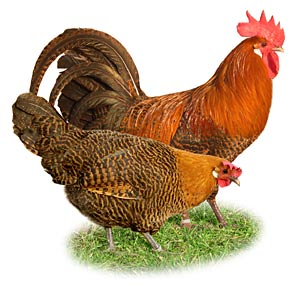
Braekel
Encyclopedia

Chicken
The chicken is a domesticated fowl, a subspecies of the Red Junglefowl. As one of the most common and widespread domestic animals, and with a population of more than 24 billion in 2003, there are more chickens in the world than any other species of bird...
breeds. Its history dates back to 1416, when it was mentioned as a successful poultry breed of the Brakel region, Belgium
Brakel
Brakel is a municipality in the Belgian province of East Flanders in the Denderstreek and the Flemish Ardennes. The name is derived from a Carolingian villa Braglo first mentioned in 866 and located in the center of Opbrakel. Since 1970, the municipality has comprised the villages of Nederbrakel,...
.
Two distinct types were recognized in the past: the large type living on rich clay soil Flanders
Flanders
Flanders is the community of the Flemings but also one of the institutions in Belgium, and a geographical region located in parts of present-day Belgium, France and the Netherlands. "Flanders" can also refer to the northern part of Belgium that contains Brussels, Bruges, Ghent and Antwerp...
, and a light-weight type from the less fertile region, the Kempen. Due to crossbreeding between the different types, this distinction vanished, resulting in a single type.
In the UK, USA and Australia, however, one can still find descendants of the Kempische Brakel under its old name 'Campine
Campine
The Campine is a natural region situated chiefly in north-eastern Belgium and parts of the south-western Netherlands which once consisted mainly of extensive moors, tracts of sandy heath, and wetlands...
'. The Campine has evolved differently from the Brakel. The most noticeable difference is the hen-feathering of the rooster and the lower weight.
The Brakel is not cultivated for its meat, but merely for its egg-laying qualities. The breed is capable of producing 180 to 200 white eggs a year.
Characteristic for the Brakel is the straight banding pattern of the feather
Feather
Feathers are one of the epidermal growths that form the distinctive outer covering, or plumage, on birds and some non-avian theropod dinosaurs. They are considered the most complex integumentary structures found in vertebrates, and indeed a premier example of a complex evolutionary novelty. They...
s and the uniform, plain neck colour. Several colour variants exist, with the gold and the silver variant being the most common.
Old names for the breed are "The Everyday Layer", "The Grey White Neck" and "The Nuns Hen".
The Brakel population declined during and after the Second World War
World War II
World War II, or the Second World War , was a global conflict lasting from 1939 to 1945, involving most of the world's nations—including all of the great powers—eventually forming two opposing military alliances: the Allies and the Axis...
and it is a rare breed.

